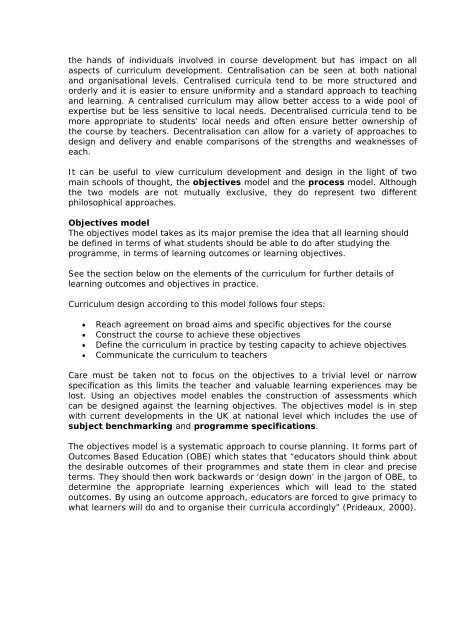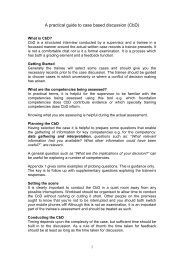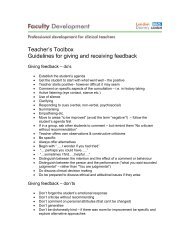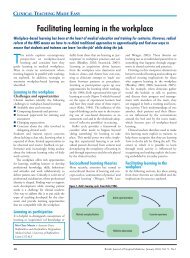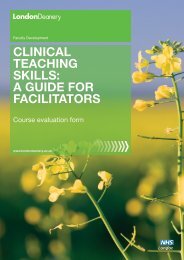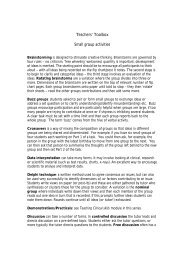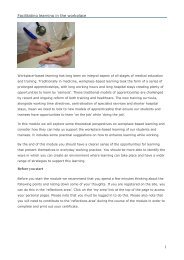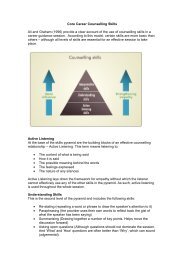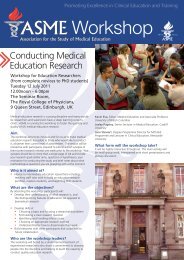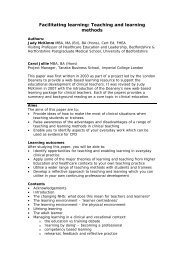Curriculum development module - Faculty Development - London ...
Curriculum development module - Faculty Development - London ...
Curriculum development module - Faculty Development - London ...
Create successful ePaper yourself
Turn your PDF publications into a flip-book with our unique Google optimized e-Paper software.
the hands of individuals involved in course <strong>development</strong> but has impact on all<br />
aspects of curriculum <strong>development</strong>. Centralisation can be seen at both national<br />
and organisational levels. Centralised curricula tend to be more structured and<br />
orderly and it is easier to ensure uniformity and a standard approach to teaching<br />
and learning. A centralised curriculum may allow better access to a wide pool of<br />
expertise but be less sensitive to local needs. Decentralised curricula tend to be<br />
more appropriate to students’ local needs and often ensure better ownership of<br />
the course by teachers. Decentralisation can allow for a variety of approaches to<br />
design and delivery and enable comparisons of the strengths and weaknesses of<br />
each.<br />
It can be useful to view curriculum <strong>development</strong> and design in the light of two<br />
main schools of thought, the objectives model and the process model. Although<br />
the two models are not mutually exclusive, they do represent two different<br />
philosophical approaches.<br />
Objectives model<br />
The objectives model takes as its major premise the idea that all learning should<br />
be defined in terms of what students should be able to do after studying the<br />
programme, in terms of learning outcomes or learning objectives.<br />
See the section below on the elements of the curriculum for further details of<br />
learning outcomes and objectives in practice.<br />
<strong>Curriculum</strong> design according to this model follows four steps:<br />
• Reach agreement on broad aims and specific objectives for the course<br />
• Construct the course to achieve these objectives<br />
• Define the curriculum in practice by testing capacity to achieve objectives<br />
• Communicate the curriculum to teachers<br />
Care must be taken not to focus on the objectives to a trivial level or narrow<br />
specification as this limits the teacher and valuable learning experiences may be<br />
lost. Using an objectives model enables the construction of assessments which<br />
can be designed against the learning objectives. The objectives model is in step<br />
with current <strong>development</strong>s in the UK at national level which includes the use of<br />
subject benchmarking and programme specifications.<br />
The objectives model is a systematic approach to course planning. It forms part of<br />
Outcomes Based Education (OBE) which states that “educators should think about<br />
the desirable outcomes of their programmes and state them in clear and precise<br />
terms. They should then work backwards or ‘design down’ in the jargon of OBE, to<br />
determine the appropriate learning experiences which will lead to the stated<br />
outcomes. By using an outcome approach, educators are forced to give primacy to<br />
what learners will do and to organise their curricula accordingly” (Prideaux, 2000).


